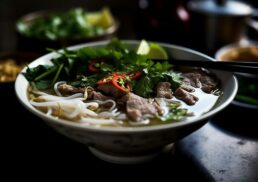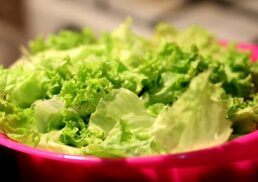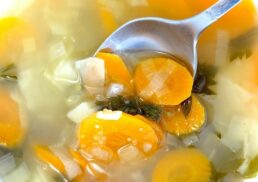Flammkuchen, a delicious German pizza originating from the Alsace region of France and neighboring German regions, is a delightful and delectable alternative to traditional Italian pizza. Imagine biting into a thin, crispy flatbread topped with rich creme fraiche, smoky bacon, and caramelized onions. Are you excited to learn more about this delicious dish and how to make it at home? You’re in for a treat!
Table of Contents
Short Summary
Discover the delicious German-style pizza, Flammkuchen – a tantalizing combination of creme fraiche, bacon and onions!
Craft the perfect dough with your choice of flour & yeast for an unforgettable experience.
Create unique recipes or explore centuries old culinary traditions from Alsace and Baden Württemberg to make mouthwatering homemade Flammkuchen!
Discovering Flammkuchen: German Pizza
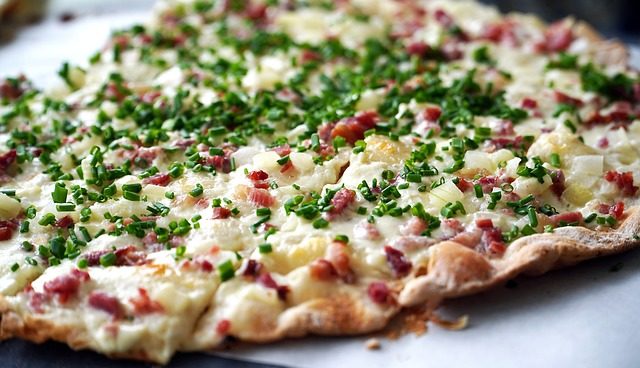
Flammkuchen, also known as Tarte Flambée, translates to “pie baked in flames” and is a mouthwatering combination of creme fraiche, thick-cut bacon, and onions atop a thin, crispy crust. Originally a homemade dish invented in Alsatian farmhouses, Flammkuchen gained mainstream exposure in restaurants during the pizza craze in the 1960s. Unlike Italian pizza, Flammkuchen is not leavened with yeast or any other leavening agent, making it more like a flatbread than a pizza. The crust of Flammkuchen is incredibly thin, crisp, and blistered, similar to a cracker, earning it the nickname “flame cake” due to its origin in wood-fired ovens, specifically the wood fired oven used in traditional preparation.
This irresistible German-style pizza is popular in France, Germany, and Austria, often found at fairs, festivals, and markets. The traditional toppings for Flammkuchen are crème fraîche or sour cream, which cooks down to a tangy white cheese topping. While the original recipe calls for only a handful of ingredients, there are countless variations to suit different tastes, making it a versatile and crowd-pleasing addition to your collection of pizza recipes.
Learn more, visit Flammkuchen (French – German Pizza).
Crafting the Perfect Dough
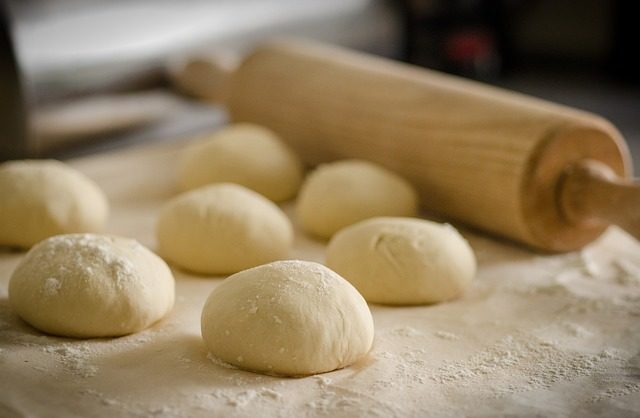
Crafting the perfect dough is essential to creating an authentic Flammkuchen experience, as well as learning how to bake bread. The dough’s ingredients and preparation will have a significant impact on the final result, from the type of flour used to the decision of whether or not to use yeast.
Let’s dive into these crucial aspects of Flammkuchen dough!
Choosing the Right Flour
Selecting the right flour for your Flammkuchen dough is crucial to achieving the desired flavor and texture. A mix of rye and wheat flour is traditional for Flammkuchen dough, giving it a unique and delicious flavor profile. In Germany, 405 flour is recommended for Flammkuchen dough. However, if you don’t have access to these specific flours, all-purpose flour can be used as a versatile and readily available alternative.
When choosing the right flour for your Flammkuchen dough, it’s essential to consider the type of flour, its texture, and the flavor it will bring to your dish. Additionally, it’s crucial to keep the recipe and the desired outcome in mind, as different flours will yield different results. Whether you opt for the traditional mix of rye and wheat flour or a more accessible all-purpose flour, selecting the right flour will set the foundation for a delicious Flammkuchen.
To Yeast or Not to Yeast?
Yeast is an optional ingredient in Flammkuchen dough, with traditional recipes typically not using yeast. However, modern recipes may include yeast to prevent the dough from drying out and ensuring a crisp-chewy crust. This choice ultimately depends on your personal preference and the type of crust you desire for your Flammkuchen.
If you decide to use yeast in your Flammkuchen dough, it can provide some benefits, such as preventing drying out and ensuring a crisp-chewy crust. On the other hand, if you prefer to stick to a more traditional approach, a yeast-free dough will yield a thinner, cracker-like crust.
Whichever option you choose, the key lies in finding the right balance of ingredients to achieve the perfect Flammkuchen crust on your baking sheet.
Essential Flammkuchen Ingredients
While the dough is a crucial component of the Flammkuchen, the toppings truly bring this German pizza to life. The essential ingredients of Flammkuchen include creme fraiche, bacon, and onions, creating a delicious and satisfying flavor combination. Using a pizza stone can help achieve that perfect crispy crust that makes this dish so irresistible.
Let’s explore these ingredients in more detail, along with some tips for selecting the best quality toppings for your Flammkuchen.
The Creme Fraiche Conundrum
As a key ingredient in Flammkuchen, creme fraiche adds a rich and tangy flavor to the dish. However, if you don’t have access to creme fraiche, sour cream can be used as a substitute, as it is similar in taste and texture. Another alternative is to use Greek yogurt, which provides a thicker consistency and a slightly tangier flavor compared to creme fraiche.
If you prefer making your own creme fraiche at home, it’s a simple process that requires just two ingredients: heavy cream and buttermilk. By mixing two cups of heavy cream with four tablespoons of buttermilk and letting the mixture sit in a warm place overnight, you can create a homemade creme fraiche that’s perfect for your Flammkuchen. Experimenting with different types of cream bases allows you to customize your Flammkuchen to your taste preferences.
Selecting Quality Bacon and Onions
Choosing quality bacon and onions for your Flammkuchen ensures a delicious and authentic taste. Smoked bacon and thinly sliced onions are highly recommended for Flammkuchen. The type of bacon used can vary, with Speck or lardons being popular choices, depending on the region.
When selecting bacon and onions for your Flammkuchen, it’s important to consider the quality and flavor they will bring to the dish. Opt for thick-cut bacon with a balance of lean meat and fat, which will render down during baking to create a rich, smoky flavor. For onions, choose ones that are firm and fresh, ensuring they will caramelize beautifully as the Flammkuchen bakes.
By choosing quality ingredients, such as freshly ground black pepper and olive oil, your Flammkuchen will be a flavorful and satisfying experience.
Shaping Your Flammkuchen: Round or Square?
Flammkuchen can be shaped into either a round or square form, with both shapes offering their own unique charm and appeal. Traditional Flammkuchen is often presented in an oval or rectangle shape, which is perfect for sharing among friends and family. Smaller, free-form-shaped Flammkuchen are common on German beer garden menus, making them a fantastic snack to enjoy with German lagers.
When shaping your Flammkuchen, whether you choose a round or square form, the key is to roll out the dough very thinly to achieve that signature crisp and blistered crust. Alternatively, you can stretch the dough into the desired shape by hand for a more rustic appearance. Whichever shape you choose, remember that the thinness of the crust is essential to achieving an authentic Flammkuchen experience.
Assembling and Baking Your German Pizza
Once you’ve crafted the perfect dough and selected your toppings, it’s time to assemble and bake your Flammkuchen. Start by rolling out the dough thinly on a lightly floured surface, then spread a generous layer of creme fraiche over it, leaving a small border around the edges. Add your delicious bacon and onion slices, and bake the Flammkuchen for 10-12 minutes at 500°F (250°C) until crisp and golden brown.
When baking your Flammkuchen, it’s essential to use a hot oven to achieve the perfect crispy crust. It’s also important not to overload your Flammkuchen with too many toppings, as this can result in a soggy crust rather than the desired crispy texture. By following these steps, you’ll be well on your way to enjoying a delicious, homemade Flammkuchen that rivals those found in the best German beer gardens and Alsatian restaurants.
Serving and Enjoying Flammkuchen
Flammkuchen is traditionally served with a cold beer or a crisp white wine, such as a German Riesling, which perfectly complements the dish’s rich and tangy flavors. To enjoy Flammkuchen in the most authentic way possible, cut it into small pieces and roll up each slice before biting into it. This method of eating Flammkuchen not only enhances the dining experience but also allows you to savor every delicious bite.
As you share your Flammkuchen with friends and family, take a moment to appreciate the rich culinary tradition of the Alsace and Baden-Württemberg regions from which it hails. A dish that was once a humble homemade creation is now enjoyed by millions of people around the world, a testament to the enduring appeal and deliciousness of Flammkuchen.
Creative Flammkuchen Variations
While the traditional combination of creme fraiche, bacon, and onions is undeniably delicious, there’s always room for creativity when it comes to Flammkuchen toppings. Contemporary variations on Flammkuchen include a plethora of options beyond the classic recipe, such as vegetarian toppings like thinly sliced pear and feta or mushrooms and blue cheese with leeks.
For those with a sweet tooth, Flammkuchen can even be transformed into a dessert by swapping out the savory toppings for sweet options like apples, cinnamon, and a drizzle of sweet liqueur. No matter which variation you choose, always remember to use a thin layer of creme fraiche as a base to maintain the dish’s signature tangy flavor. Discover the perfect flammkuchen recipe to satisfy your cravings.
The possibilities are endless, so don’t be afraid to get creative in the kitchen and come up with your own unique Flammkuchen recipes.
Flammkuchen in Context: Alsace and Baden-Württemberg Cuisine
Flammkuchen is just one of many delicious dishes that are part of the rich culinary tradition of the Alsace and Baden-Württemberg regions. Other dishes from these regions include German Onion Pie, Choucroute Garnie (a hearty dish of sauerkraut, sausages, and other meats), Kartoffelpuffer (potato pancakes), and White Asparagus with Hollandaise sauce. These dishes showcase the unique flavors and ingredients that make Alsace and Baden-Württemberg cuisine so special.
By exploring the culinary traditions of these regions, you’ll gain a deeper appreciation for the origins of the Flammkuchen and the diverse flavors that define the cuisine of Alsace and Baden-Württemberg. Whether you’re sampling Flammkuchen at a local beer garden or preparing it at home, you’ll be partaking in a centuries-old culinary tradition that continues to delight and inspire food lovers around the world.
Tips for Making Flammkuchen at Home
Making Flammkuchen at home is a fun and rewarding experience, and with a few tips, you’ll be well on your way to creating an authentic and delicious dish. One practical tip is to prepare your toppings in advance, such as slicing the bacon and onions, which will make the assembly process much smoother. If you’re short on time or don’t feel confident making the dough from scratch, using store-bought dough is a convenient option that can still yield delicious results.
Another important aspect of enjoying Flammkuchen is to embrace the traditional way of eating it by hand. By cutting your Flammkuchen into small pieces and rolling up each slice, you’ll be able to fully appreciate the unique flavors and textures that make this German pizza such a beloved dish.
With these tips in mind, you’re ready to embark on your own Flammkuchen adventure and discover the joy of making this delectable dish at home.
Summary
In conclusion, Flammkuchen is a delicious and unique German pizza that offers a delightful alternative to traditional Italian pizza. From crafting the perfect dough to selecting quality ingredients and exploring creative variations, making Flammkuchen at home is a fun and rewarding experience. Embrace the rich culinary tradition of the Alsace and Baden-Württemberg regions as you enjoy your homemade Flammkuchen with friends and family. It’s time to roll up your sleeves, fire up the oven, and embark on your Flammkuchen journey!
Frequently Asked Questions
What is the difference between Flammkuchen and pizza?
Flammkuchen may look like pizza, but it’s actually a thinner and crispier flatbread that is not leavened with yeast and topped with a creamy blend of crème fraiche, Greek yoghurt, salt, pepper, and nutmeg, rather than tomato sauce.
This unique combination of ingredients gives Flammkuchen a unique flavor that is both savory and creamy. It is a popular dish in Germany, Switzerland, and Austria, and is often served as an appetizer or snack.
What is Flammkuchen made of?
Flammkuchen is a delicious treat from the Alsace region of France and popular across Germany and Austria too! It’s made with a crispy flatbread topped with creme fraiche, bacon or lardons, and onions – simply mouthwatering!
The toppings are what make this dish so special. The combination of creamy creme fraiche, salty bacon or lardons, and sweet onions creates a flavor that is truly unique. The flatbread. The flatbread.
Is Flammekueche French or German?
Flammkuchen is a popular delicacy originating in the Alsace region of France, but was created by German settlers – making it both French and German!
It is also popular in Austria.
Can I use all-purpose flour for Flammkuchen dough?
Yes, you can absolutely use all-purpose flour to make your Flammkuchen dough – it’s an easy and accessible alternative!
What can I substitute for creme fraiche in Flammkuchen?
Swap out creme fraiche in your Flammkuchen for a delicious sour cream or Greek yogurt substitute – your taste buds will thank you!


